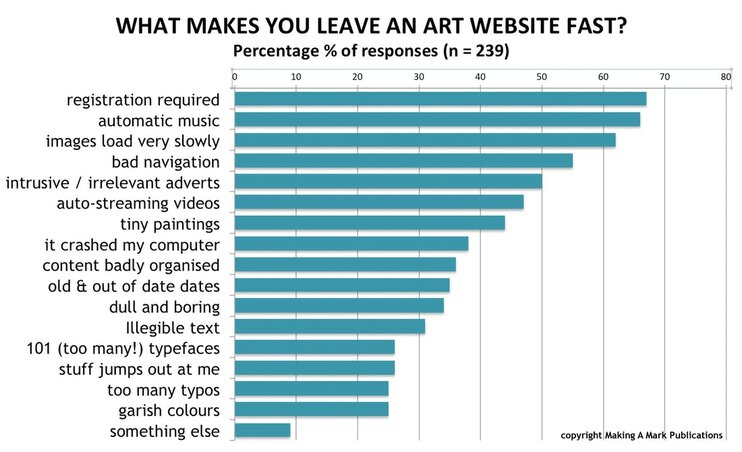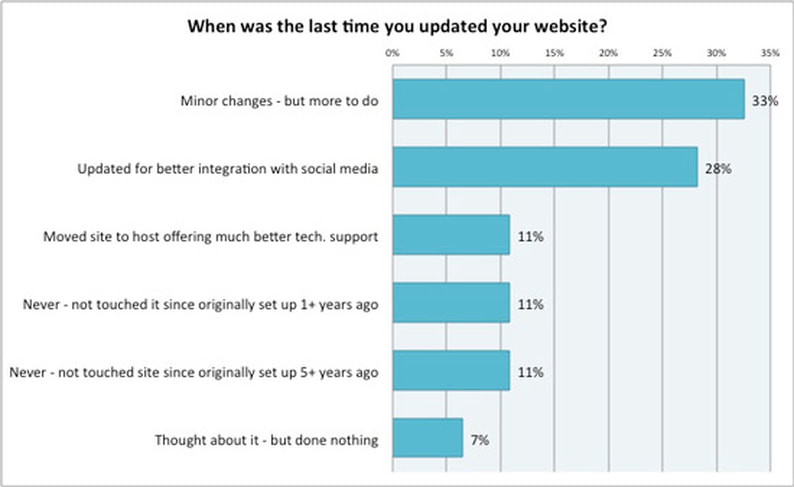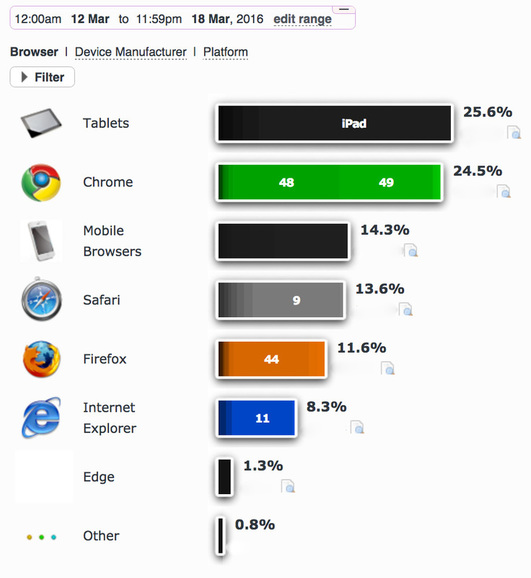- Home
- NEWS
-
PRACTICE
-
MARKETING
- How to write an Artist's Statement >
- How to write an Artist's Resume or CV >
- How to sign a painting, drawing or fine art print
- Business Cards for Artists
- How to write a press release for an artist
- The Private View Invitation
- Publicity for Juried Exhibitions
- Websites for Artists >
- Image & Video sizes for Social Media Sites
- How to be mobile-friendly
-
SELL ART
- FRAME ART
-
SHIP ART
-
COPYRIGHT
-
MONEY & TAX
- About + Help
- BANKING
The basics of web design and a checklist of factors which need to be addressed
|
This page considers:
|
There has never been a better time for artists to build their on websites using webware which is very easy to use - and involved absolutely no coding.
However you still need to understand some of the basics of website design. At the end of this page, I will be developing links to further reading. Unless otherwise indicated the links are to posts on my blog where I've written extensively on this topic. |
Key considerations for website design
There are many excellent websites, blogs and books which provide an excellent introduction to contemporary website design. (I shall be developing a list of recommended books at the end of this page)
Here's a top-level list of the headlines of the things you need to think about:
Here's a top-level list of the headlines of the things you need to think about:
|
Technology and Software / Mobile friendliness
Websites MUST be:
Design
Page Layout
|
Navigation
Text and Images
REFERENCE: |
A Design Check List
Below are articles which provides information and tips on website design
|
Layout
The importance of the page fold
These articles explain what the page fold is, why it varies in placement from screen to screen and why what appears above the page fold still matters
|
Mobile-Friendly
This website contains a section on How to be mobile-friendly
- Are your sites mobile friendly - or are you facing Mobilegeddon? - A technical change by Google means that all sites which are mobile compatible will get an uplift in search rankings. This post reviews looks at how Google will encourage more sites on the internet to become mobile friendly - and why it's important to us all.
- Fix mobile usability issues found on..... - Google is initiating a major drive on mobile usability and a lot of people are getting these emails
In 2013, I ran a poll to find out where artists were up to in terms of updating their website
In 2013, some 28% of you had updated your website so it integrates better with social media. A third of you recognised that you need to do more to keep up with the technological change associated with the explosion on the use of mobile devices
Browser friendly
A key indicator of a contemporary template is that it works with recent versions of every browser.
Once upon a time Internet Explorer dominated web browsers. Those days are long gone (see above chart)
It's now essential that websites are designed to be compatible with every commonly used browser - including and especially ones that are specifically designed to be used with mobile devices.
You don't need to worry about the older versions. You do need to worry about all the updates and new versions!
If somebody asks me to take a look at their new website (and I only do this for free for friends!) I always make sure that I look at it on my iMac, Mini iPad and my iPhone (e.g. see Brand new website raises design standard for art societies) and I use different browsers to do this.
Once upon a time Internet Explorer dominated web browsers. Those days are long gone (see above chart)
It's now essential that websites are designed to be compatible with every commonly used browser - including and especially ones that are specifically designed to be used with mobile devices.
You don't need to worry about the older versions. You do need to worry about all the updates and new versions!
If somebody asks me to take a look at their new website (and I only do this for free for friends!) I always make sure that I look at it on my iMac, Mini iPad and my iPhone (e.g. see Brand new website raises design standard for art societies) and I use different browsers to do this.
Page Load Speed
How long does it take for your page to appear?
Speed on an image-based website is largely determined by
This is Google's advice about how to test your website - and benchmark, evaluate and optimise it using the "Test my Site" tool developed by Google
(NOTE: my link is the GB link - you may need a different one. Just search for https://www.thinkwithgoogle.com/ to get the right country for you.)
You can also test how fast your website is.
- overall size of the website
- file size (based on resolution, actual dimensions and file type).
- the speed of your broadband - and how good the connection is
This is Google's advice about how to test your website - and benchmark, evaluate and optimise it using the "Test my Site" tool developed by Google
(NOTE: my link is the GB link - you may need a different one. Just search for https://www.thinkwithgoogle.com/ to get the right country for you.)
You can also test how fast your website is.
- Use Google PageSpeed Insights Tool to check how fast your website loads - Do you know how well your website or blog renders on a mobile device or a normal computer?
- This website tool from Pingdom allows you to test how fast your website page loads. Note you do NOT get unlimited free tests every month.
ADVERTS
|
|
|
Text for an artist's site
Writing for the webTips for writing text on websites and blogs
|
CaptionsKeep your captions consistent - decide what to include in a caption eg
|
Web contentHow your website ranks in response to google searches depends on the quality of the content as well as the number of people who follow an artist.
REFERENCE
|
Buyers' "need to know" informationYou must advise people of what they are buying in terms of presentation and "add ons"
|
Images for an artist's site
Image oriented design
You may have noticed that websites which have had a makeover recently are getting bigger and better images. Images are becoming very prominent on all sorts of sites.
A contemporary website design for an artist's website should provide a range of ways for displaying images.
|
Image size and definitionIf you want people to but your art, people need to see what they are buying. On the other hand the speed of your website is a major factor in it ranking well.
TIPS:
|
Sell Art
|
See also my section on this website about Selling Art
Things you need to think about when trying to sell art via your website include:
Most importantly, you need to think about which WAY to sell art
|
Reasons why your art does not sell from your website
|
REFERENCE:
- How to Fix Common Design Mistakes that Hurt Your Online Sales - what turns people off and what fails to turn people on to buying your art
- 5 Costly Mistakes That Will Stop You From Selling Your Art - a checklist that will help you sell your art and stories without selling your soul…
- How To Sell Art Online – Make Money From Your Passion - Creating an online gallery and selling your work has never been easier.
Websites to look at
Below are some suggestions of websites to look at. None of them are perfect but all have something to help us understand what is possible.
- Brand new website raises design standard for art societies - Has your art society updated its website to cope with mobile devices and changes in the way Google ranks websites?
- The Mall Galleries has a NEW website - a review of the new Mall Galleries website - highlighting new features and better presentation of information.
- The Royal Academy of Arts has a new website - A short review of the brand new website for the Royal Academy of Arts which has been devised in response to its new digital strategy for creating engagement with its target audiences
- Search Quality Guidelines: Find out how Google rates websites
An overview of the guidelines Google publishes on how it rates website content and value to those searching for information.
|
GO TO: COMMUNICATION
|
ADVERT
|
ABOUT ART BUSINESS INFO. FOR ARTISTS
This website aims to provide a compendium of resources about the art business for artists. Please read "PLEASE NOTE"
It helps artists learn how to do better at being business-like, marketing and selling their art and looking after their financial security.
This website aims to provide a compendium of resources about the art business for artists. Please read "PLEASE NOTE"
It helps artists learn how to do better at being business-like, marketing and selling their art and looking after their financial security.
|
Copyright: 2015-2021 Katherine Tyrrell | Making A Mark Publications
- all rights reserved If you've got any suggestions for what you'd like to see on this website please send me your suggestion
|
PLEASE NOTE:
1) Content and the law change all the time. It's impossible to keep up with it if you're not working on the topic full time. 2) I research topics carefully. However, I am totally unable to warrant that ANY and/or ALL information is
|
3) Hence all information I provide comes without any LIABILITY whatsoever to you for any choices you make.
4) This website is FREE FOR YOU but not for me. Links to books are Amazon Affiliate links. Buying a book via this website means I get a very small payment which helps to fund and maintain this website. .I much appreciate any support your provide. Adverts are provided by Google AdSense - but the adverts do not mean I endorse the advertiser. |
- Home
- NEWS
-
PRACTICE
-
MARKETING
- How to write an Artist's Statement >
- How to write an Artist's Resume or CV >
- How to sign a painting, drawing or fine art print
- Business Cards for Artists
- How to write a press release for an artist
- The Private View Invitation
- Publicity for Juried Exhibitions
- Websites for Artists >
- Image & Video sizes for Social Media Sites
- How to be mobile-friendly
-
SELL ART
- FRAME ART
-
SHIP ART
-
COPYRIGHT
-
MONEY & TAX
- About + Help
- BANKING



